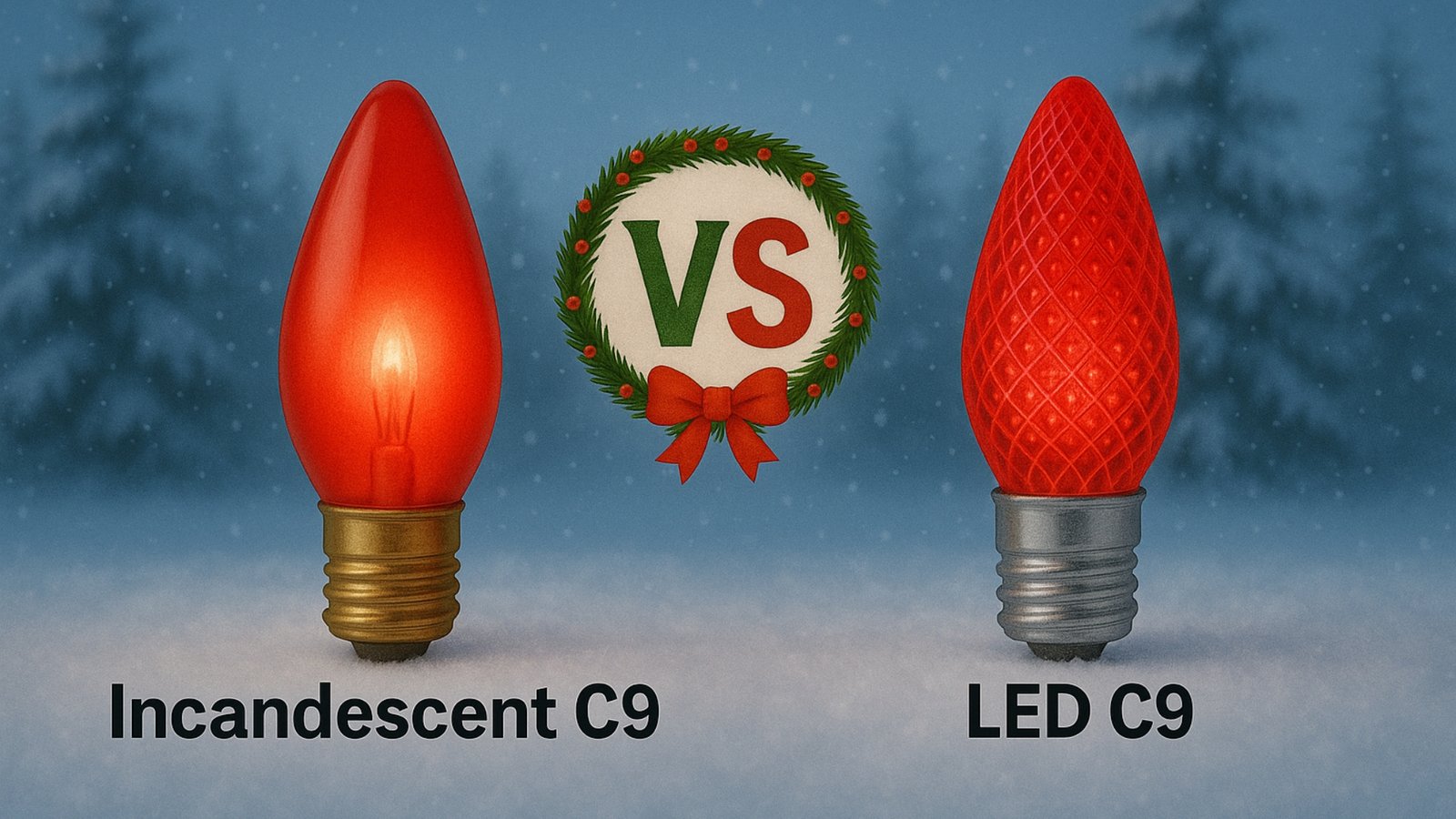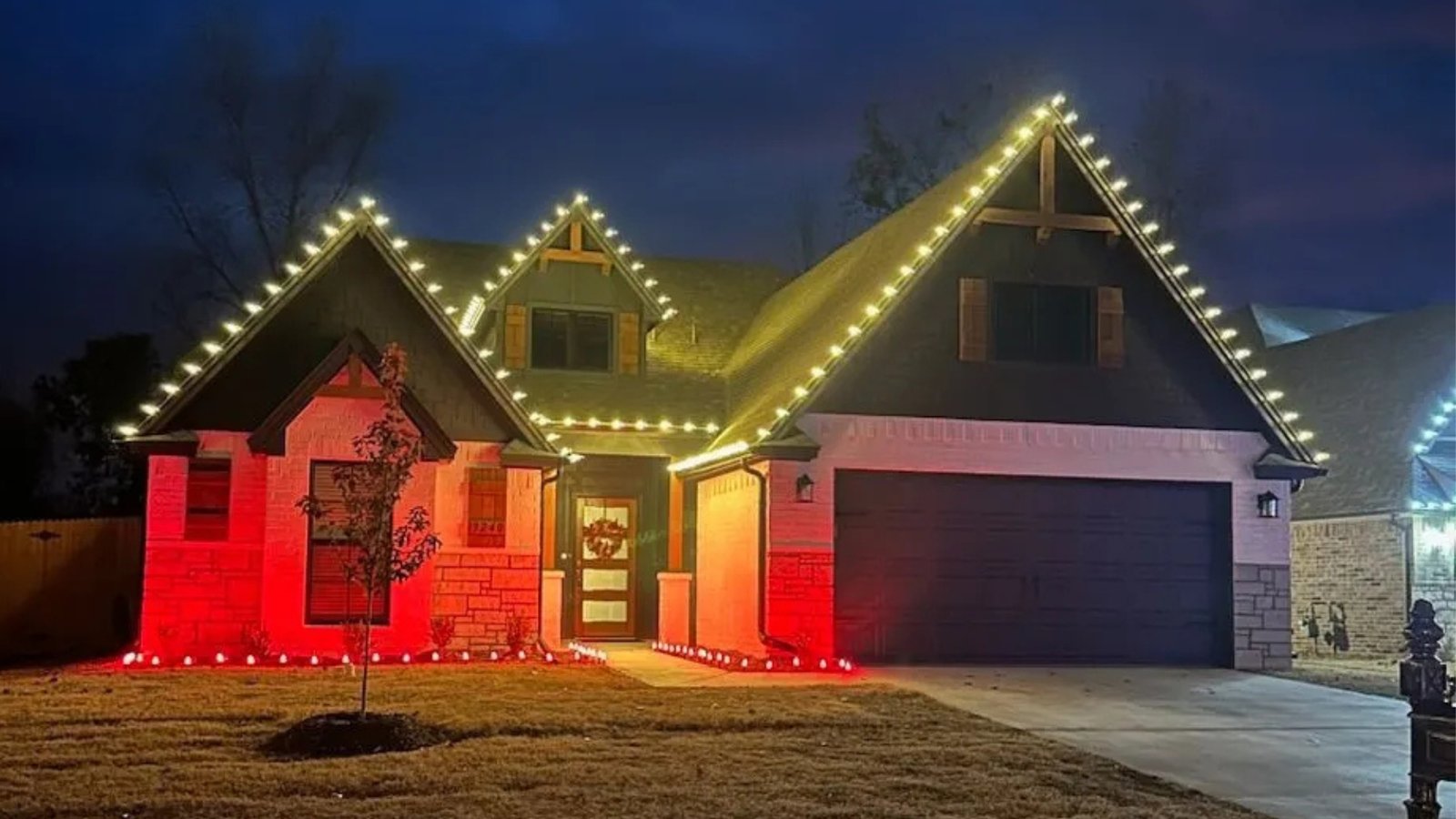C9 vs LED C9 – A Simple Guide for Your Home

Shoppers in Tulsa and Broken Arrow often see regular C9 bulbs next to LED C9 bulbs and wonder which will look better, cost less to run, and hold up through cold snaps. The names sound similar, yet the two technologies behave very differently once they are clipped along peaks, valleys, and gutters. This C9 vs LED C9 comparison explains what C9 really means, how LED C9 delivers the classic look with modern benefits, and how to choose the right option for your home.
What C9 means
C9 refers to a cone shaped bulb that is easy to read from the street. It is the classic roofline size many people remember from childhood displays. Regular C9 bulbs use a tiny filament and are commonly rated near seven watts. LED C9 bulbs use light emitting diodes to create the same visual effect while drawing well under one watt. That power difference is the source of most of the practical wins you will notice in Tulsa and Broken Arrow, and it sits at the heart of the C9 vs LED C9 choice most homeowners make each season.
Brightness and look with LED C9 bulbs
Brightness is not only about lumens on a package. It is also about how the lens spreads light and how the outline reads at dusk. Regular C9 bulbs create a soft edge that many describe as a warm glow. LED C9 bulbs now use clear or faceted lenses that mimic vintage sparkle without harsh points of light. If you have red or tan brick, warm white LED C9 bulbs in the 2700 to 3000 Kelvin range create a candle like tone that feels welcoming. If your exterior is gray or has stone accents, cool white LED C9 bulbs create a clean modern outline that photographs well. In short, the real world look of C9 vs LED C9 in Tulsa neighborhoods depends on color temperature, lens style, and even spacing far more than it does on a spec sheet.

Energy use and cost in Tulsa and Broken Arrow
Energy use is where LED C9 bulbs stand out. Consider a simple season. One hundred bulbs on for eight hours each night for sixty nights will use about 336 kilowatt hours with regular C9 bulbs near seven watts each. At a common local rate of twelve cents per kilowatt hour, that is about forty dollars for one roofline. The same layout with LED C9 bulbs at about zero point eight watts uses roughly 38.4 kilowatt hours, or about five dollars. That is a savings near thirty six dollars on a single run in one season. Lower draw also lets you place longer lines on a circuit, reduces extension cords, and means fewer breaker resets on cold evenings. When you frame C9 vs LED C9 in simple dollars for a Tulsa roofline, LED C9 becomes the clear favorite.
Safety, heat, and lifespan
Regular C9 bulbs run hot to the touch. Heat can stress sockets, clips, and nearby dry foliage. LED C9 bulbs run cool, which lowers risk around gutters and siding and makes ladder time more comfortable. Both options should use GFCI outlets, outdoor rated cords, and tidy cable runs for safety and a clean look. Lifespan favors LEDs. Filaments burn out and glass breaks. LED C9 bulbs are rated for many thousands of hours and many use durable polycarbonate lenses that handle freeze and thaw cycles better. Keep a small labeled set of spare bulbs so mid season swaps are fast. From a maintenance angle, the C9 vs LED C9 decision usually comes down to whether you want fewer mid season trips up the ladder.
Color options and consistency
Color on regular C9 bulbs comes from tinted or painted glass that can fade in storage. LED C9 bulbs are built to a color target and show strong batch consistency. Warm white and cool white remain the most popular choices, but bold solid colors and candy cane red and white are now common. If you want a perfect match next year, buy from one lot and label the storage bin by color and season. When you document your display, use clear file names and alt text such as Warm white LED C9 roofline on brick homes at dusk to make next year easy. This is another place where C9 vs LED C9 in Tulsa often ends with LED, since consistent batches make expansions simple.
Installation and control tips
You can retrofit LED C9 bulbs into existing C9 cords for a classic look, or run prewired LED strings for faster installs on long lines. The most important visual rule is to keep intervals even at peaks and corners. Start at a GFCI outlet, plan the return path, and avoid stretches across walkways. For control, LED C9 bulbs work well with smart plugs and timers. Set dusk on and a scheduled shutoff so your display runs without daily adjustments. If you want a gentle fade or a twinkle, choose LED bulbs marked as dimmer friendly and test the effect for a few nights. For layout ideas and a quick count, visit custom holiday lighting design to see what all we offer.
Conclusion
If you want the classic C9 style with lower energy, cooler operation, consistent color, and a long service life, choose LED C9 bulbs. Regular C9 bulbs still have a place in short vintage scenes that need a true filament glow, but for daily use on homes in Tulsa and Broken Arrow, LED C9 bulbs deliver the look you expect with fewer tradeoffs. When you step back and compare C9 vs LED C9 across cost, safety, color, and lifespan, LED wins for most rooflines. When you are ready to get started, reach out to us for a fast easy quote.
Keep your property looking sharp all season.
Tell us about your property and get a fast and transparent quote.

